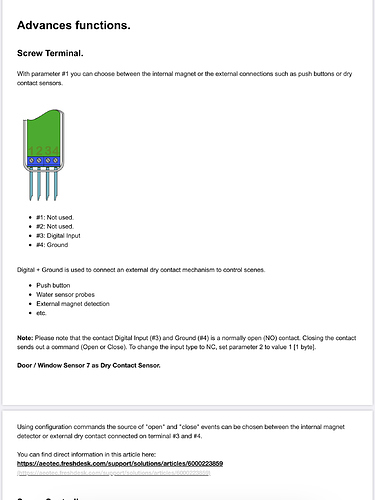I've been using zigbee contact sensors, but have issues of them dropping off (maybe because steel doors). Rather than fix the issue, looking to switch to Z-Wave. Any recommendations on contact sensors? Looking for smallest form factor possible. Cost is an issue. (Posting here rather than in devices, since it's not a "support" issue.)
Around $25-30/ea is about as cheap as I've seen zwave plus contact sensors new.
Edit: I stand corrected. The NEO and monoprice ones on Amazon are both $20.
May be able to find some cheaper on eBay though.
I use Aeotec Door/Window Sensor 7, very happy, but may not meet your cost sensitivity requirement. It also has external contacts for physical wire input if you disable magnet sensor.
Looks good. Price is hefty, especially since I'll want a dozen +, but I can get them subscription style over time. Know what the "dry contact" feature is about?
Prolly should have put this in my TL post, but I have steel doors... Good chance that's my issue with Zigbee. You know if they work with steel?
Bought some of these but haven't connected them yet and I got them based on another user here also getting some:
It's a lot of 10 but it works out to $5 a sensor. They are zigbee.
Yes. Like I said, there are external terminals that you can use and disable the internal magnet sensor, so you can use it to report status of an external contact or switch:
You can use something else other than it's magnet to trigger the sensor. So for instance, I have a "dumb" beam sensor that when trips it sends signal to tell the Aeotec to close/open via the dry contacts (thereby alerting my home automation setup)
Just to ask, are you sure your Zigbee mesh is robust enough and is not the cause of the drops? Because if you just switch to Z-Wave, you could have the same problem if that mesh is not robust enough.
And check your zigbee and wi-fi channels for interference.
How many smart bulbs do you have? These are known to cause issues with Zigbee.
A "dry" contact is simply a contact that is not connected to any power supply. Or think if it as a switch with two leads connected to nothing else (until you connect it to your sensor).
I think the idea of using an "external dry contact" is: If you use a simple alarm contact/magnet set on the door, and move the Zigbee device away from the metal door you will likely have less connection issues.
Thought.... If you Zigbee device is on the door with the magnet on the door frame, You might have better luck if the Zigbee device was on the frame (wood?) and the magnet on the door. Or maybe the metal door will make the magnet less effective.
I have at least a dozen ZLL bulbs, and have no issues with them. Mostly contact sensors. Although the steel doors may be a factor, I've also had issues with other Zigbee sensors. However, all of them can be categorized as either 1) On a steel door, or 2) Xiaomi. For possible interference or weak network... My solution is to switch to Z-Wave. Not had any problem with any Z-Wave device.
There's nothing wrong with going Z-Wave if you want to. Just don't be dumb and get non-plus zwave devices, or you will wish that you didn't do anything at all. 
You won't. But they will cause havoc with everything else. Sengled are fine, but many other bulbs are horrible to your mesh.
Those also might be an issue in themselves, but could be worse if you don't have repeating devices, or if the bulbs are knocking them offline.
I get that you want Zwave, but don't be so fast to blame Zigbee sensors or your metal doors.
Might simply adding some zigbee repeaters in the area of the doors help?
Not blaming them, just have an easy solution. The only Zigbee device I'll miss is the Xiaomi MagicCubes, but as you say, those are an issue by themselves.
If you want to confirm your suspicions (re: Zigbee signal strength) HE provides pretty good tools to diagnose mesh issues. Check Settings>Zigbee Details>Zigbee Logging page; leave it open and activate a sensor. You should see the device report the signal strength of the 'last hop router' (if it is using a repeater; otherwise it will be the actual received signal strength of the device itself). As the numbers approach the high negative 80's (higher negative numbers are worse) your signal is down in the noise floor and a repeater in the path should help (or a migration to Z-Wave, if that is your choice).


